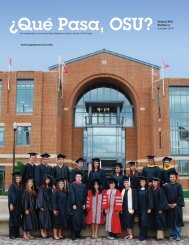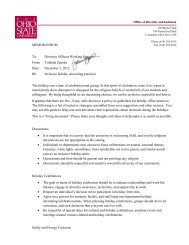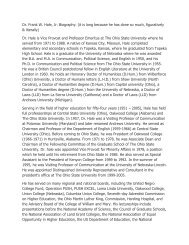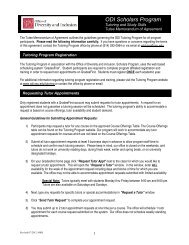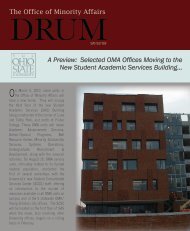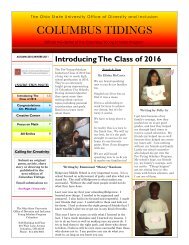Qué Pasa, OSU? - go to site
Qué Pasa, OSU? - go to site
Qué Pasa, OSU? - go to site
- No tags were found...
Create successful ePaper yourself
Turn your PDF publications into a flip-book with our unique Google optimized e-Paper software.
In<strong>to</strong> the OceanCaring for Marine Life Leads Michael Flores <strong>to</strong> Oc<strong>to</strong>pus Intelligence ResearchBy Yolanda Zepeda, Office of Diversity and InclusionPHOTO PROVIDED BY MICHAEL FLORESAre you smarter than an oc<strong>to</strong>pus?Michael Flores spent a summer finding out.A fourth-year student majoring in marinescience in the School of Environment andNatural Resources—Fisheries Science,Michael spent the summer of 2011 on thebeach in South Padre Island, Texas. Hewasn’t playing volleyball or working on histan. Michael was building complex mazesand training a veined Indonesian oc<strong>to</strong>pusnamed JD in a series of puzzles and gamesdesigned <strong>to</strong> test oc<strong>to</strong>pus intelligence.Michael interned at the South PadreIsland Dolphin Research and Sea lifeNature Center, a non-profit organizationdedicated <strong>to</strong> educating the public aboutthe bottlenose dolphins native <strong>to</strong> the Gulfof Mexico. The Center features marineanimals native <strong>to</strong> the area including livefish, starfish, crabs, oc<strong>to</strong>pus, and snails.Originally an unpaid intern at the Center,Michael fed and cared for the animals. “I’vealways loved the ocean,” he says, “and Ihave always known that I wanted <strong>to</strong> spendmy life doing something related <strong>to</strong> marinelife.”For his oc<strong>to</strong>pus intelligence research,Michael ordered two small, Indonesianveined oc<strong>to</strong>pi after unsuccessful attempts<strong>to</strong> trap local specimens. As it turned out,they were small and not well suited forthe mazes. Then one day a child snaggeda three-foot veined oc<strong>to</strong>pus while fishing.Michael retrieved it and named him JD.Soon he and JD would begin a dailyregimen that included feeding, hoursworking with puzzles and mazes, andsharing an evening of television at theCenter. Michael laughs as he recalls howJD warmed up <strong>to</strong> him over time, movingacross the tank <strong>to</strong> be nearer <strong>to</strong> Michael asthey viewed their favorite shows, “JD wasgreat, he even climbed out of his tank andsat on the <strong>to</strong>p, kicking back and watchingTV with me.”JD’s intelligence tests involved beingplaced in<strong>to</strong> a six-foot maze made ofmovable, silicon walls, with a live crab“prize” at the end of the maze. The trialsdemanded learning on both JD’s andon Michael’s part. For instance, in earlydesigns, the crab climbed out of the box atthe end of the maze and approached theoc<strong>to</strong>pus, essentially helping JD <strong>to</strong> solve thepuzzle and speeding up his own demise.Michael adapted the design <strong>to</strong> contain thecrab, but then JD learned how <strong>to</strong> grasp andpull down the walls, destroying the maze<strong>to</strong> get his prize. “Over the weeks, I builtmazes, and JD destroyed them. He is smartand surprisingly strong.”Caring for JD and the other marine lifeat the Center didn’t involve merely shakinga can of Tetra over their tanks. Since theoc<strong>to</strong>pus refused anything but live food,Michael began and ended his days wadingwaist-deep in the gulf <strong>to</strong> catch small fish,shrimp, and crabs. He describes beingsomewhat unnerved “as I s<strong>to</strong>od there inthe evenings with the sun <strong>go</strong>ing down, inwater up <strong>to</strong> my waist, as I watched the finsof the blacktip sharks that were common<strong>to</strong> the area glide back and forth in thedistance. It was eerie.”He also collected other memorableexperiences like the birth of sea horses.“We had been watching our seahorse fordays waiting for it <strong>to</strong> give birth,” Michaelrecalls. “One day, we noticed that the waterwas really cloudy, so my assistant turnedup the filter pump. The water wasn’tgetting clearer and when we investigated,we noticed that the seahorse had givenbirth. Unfortunately, many of the fry werestuck <strong>to</strong> the filter!” Michael describes howhe and his assistant spent the better par<strong>to</strong>f that day painstakingly removing thetiny, newborn seahorses from the tank filterwith a pair of tweezers.Eventually, Michael’s unpaid internshipled <strong>to</strong> a paid position as manager of theCenter, carrying with it responsibility formaintenance of the Center and care of themarine life. With room and board providedby the Center’s direc<strong>to</strong>r, the internshipproved not only intellectually enriching butfinancially rewarding as well. Michael also<strong>to</strong>ok advantage of the chance <strong>to</strong> refreshhis Spanish language skills weakened fromfour years of disuse in Ohio, as he pledged<strong>to</strong> speak only Spanish with his assistantwho spoke little English. The assistant waspatient with Michael’s rusty Spanish, as hehimself struggled with his own pledge <strong>to</strong>speak only English.Reflecting on his summer at PadreIsland, Michael talks about it being oneof the best experiences ever. When hereturned <strong>to</strong> Columbus at the end of thesummer, he continued <strong>to</strong> engage inresearch as a research assistant with the<strong>OSU</strong> Fresh Water Mussel Facility. With oneyear of school remaining, Michael is excited<strong>to</strong> begin a career in marine science and hasno doubts about achieving his dream. Buthis academic journey has not been withoutchallenges.As a high school student in San Juan,Texas, Michael didn’t aspire <strong>to</strong> attendcollege. Although he was an honorsstudent and had completed a number ofcollege courses in high school, Michaeladmits, “I never really believed that acollege education was for me. I was just<strong>go</strong>ing <strong>to</strong> graduate from school and get ajob.” His high school counselor recognizedMichael’s talent, prompting him <strong>to</strong> applyfor college admission. Under the Texas TopTen Percent plan, Michael was admitted <strong>to</strong>any state college of his choice, and receivedfull scholarship offers from several schoolsincluding the University of Texas.Enter Maria Sanchez, academic coordina<strong>to</strong>rfrom Ohio State University’s Office ofMinority Affairs (now the Office of Diversityand Inclusion). Maria vi<strong>site</strong>d Michael’shigh school, and her enthusiasm about theofferings of Ohio State was persuasive. Ascholarship offer sealed the deal. The onlyobstacle standing between Michael andhis Buckeye adventure was his family. Like20




